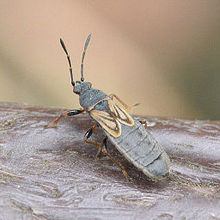| Blissidae | |
|---|---|

| |
| Ischnodemus sabuleti | |
| Scientific classification | |
| Domain: | Eukaryota |
| Kingdom: | Animalia |
| Phylum: | Arthropoda |
| Class: | Insecta |
| Order: | Hemiptera |
| Suborder: | Heteroptera |
| Infraorder: | Pentatomomorpha |
| Superfamily: | Lygaeoidea |
| Family: | Blissidae Stål, 1862[1] |
The Blissidae are a family in the Hemiptera (true bugs), comprising nearly 50 genera and 400 species.[2] The group has often been treated as a subfamily of the Lygaeidae but was resurrected as a full family by Thomas Henry (1997).[3]
The adult insects are elongate, typically four times as long as broad, and in some species, up to seven times. Short wings are common in many species.
All the species feed on the sap of plants, mostly grasses, and most of the species live between the sheaths of leaves.[2] The most economically important species is the true chinch bug, Blissus leucopterus, a destructive pest of corn crops in the United States.